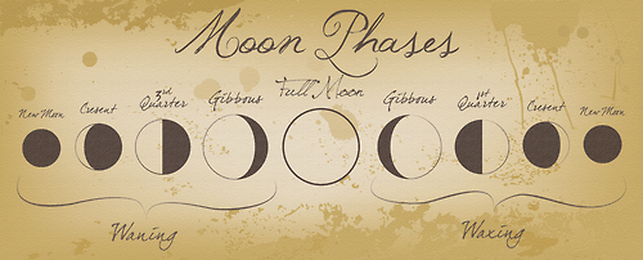As you might easily guess, a lunar calendar is based on cycles of the lunar phases. Because there are slightly more than twelve lunations or synodic months (months with approximately 29 days) in a solar year, the period of 12 lunar months (354.37 days) is sometimes referred to as a lunar year.
A common purely lunar calendar, for example, is the Islamic calendar or Hijri Qamari calendar. A feature of the Islamic calendar is that a year is always 12 months, so the months are not linked with the seasons and drift each solar year by 11 to 12 days. It comes back to the position it had in relation to the solar year approximately every 33 Islamic years. It is used mainly for religious purposes, but in Saudi Arabia it is the official calendar. Other lunar calendars often include extra months added occasionally to synchronize it with the solar calendar. The oldest known lunar calendar was found in Scotland; it dates back to around 10000 BP.
Curiously, though, most calendars referred to as "lunar" calendars are in fact lunisolar calendars. That is, months reflect the lunar cycle, but then intercalary months are added to bring the calendar year into synchronisation with the solar year. Some examples are the Chinese and Hindu calendars. Some other calendar systems used in antiquity were also lunisolar. All these calendars have a variable number of months in a year. The reason for this is that a solar year is not equal in length to an exact number of lunations, so without the addition of intercalary months the seasons would drift each year. To synchronise the year, a thirteen-month year is needed every two or three years.
Some lunar calendars are calibrated by annual natural events which are affected by lunar cycles as well as the solar cycle. An example of this is the lunar calendar of the Banks Islands, which includes three months in which the edible palolo worm mass on the beaches. These events occur at the last quarter of the lunar month, as the reproductive cycle of the palolos is synchronised with the moon.
Even though the Gregorian calendar is in common and legal use, lunar and lunisolar calendars serve to determine traditional holidays in many parts of the world, including India, China, Korea, Japan, Vietnam and Nepal. Such holidays include Ramadan, Diwali, Chinese New Year, Tết (Vietnamese New Year), Mid-Autumn Festival/Chuseok and Nepal Sambat and Mongolian New Year as called Tsagaan sar, to name a few.
A common purely lunar calendar, for example, is the Islamic calendar or Hijri Qamari calendar. A feature of the Islamic calendar is that a year is always 12 months, so the months are not linked with the seasons and drift each solar year by 11 to 12 days. It comes back to the position it had in relation to the solar year approximately every 33 Islamic years. It is used mainly for religious purposes, but in Saudi Arabia it is the official calendar. Other lunar calendars often include extra months added occasionally to synchronize it with the solar calendar. The oldest known lunar calendar was found in Scotland; it dates back to around 10000 BP.
Curiously, though, most calendars referred to as "lunar" calendars are in fact lunisolar calendars. That is, months reflect the lunar cycle, but then intercalary months are added to bring the calendar year into synchronisation with the solar year. Some examples are the Chinese and Hindu calendars. Some other calendar systems used in antiquity were also lunisolar. All these calendars have a variable number of months in a year. The reason for this is that a solar year is not equal in length to an exact number of lunations, so without the addition of intercalary months the seasons would drift each year. To synchronise the year, a thirteen-month year is needed every two or three years.
Some lunar calendars are calibrated by annual natural events which are affected by lunar cycles as well as the solar cycle. An example of this is the lunar calendar of the Banks Islands, which includes three months in which the edible palolo worm mass on the beaches. These events occur at the last quarter of the lunar month, as the reproductive cycle of the palolos is synchronised with the moon.
Even though the Gregorian calendar is in common and legal use, lunar and lunisolar calendars serve to determine traditional holidays in many parts of the world, including India, China, Korea, Japan, Vietnam and Nepal. Such holidays include Ramadan, Diwali, Chinese New Year, Tết (Vietnamese New Year), Mid-Autumn Festival/Chuseok and Nepal Sambat and Mongolian New Year as called Tsagaan sar, to name a few.
~Ally

 RSS Feed
RSS Feed